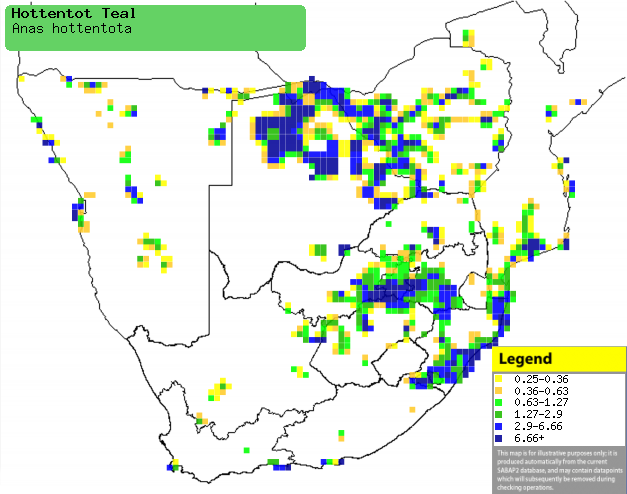|
Anas hottentota (Hottentot
teal)
Gevlekte eend [Afrikaans]; iDada (generic term for duck)
[Zulu]; Siwoyo (generic term for duck) [Kwangali]; Letata (generic term for
duck) [South Sotho]; Dada, Sekwe (both are generic names for duck or goose)
[Shona]; Sekwa (generic term for duck or goose) [Tsonga]; Sehudi (generic term
for duck) [Tswana]; Hottentottaling [Dutch]; Sarcelle hottentote [French];
Hottentottenente, Pünktchenente [German]; Marreco-hotentote [Portuguese]
Life
> Eukaryotes >
Opisthokonta
> Metazoa (animals) >
Bilateria >
Deuterostomia > Chordata >
Craniata > Vertebrata (vertebrates) > Gnathostomata (jawed
vertebrates) > Teleostomi (teleost fish) > Osteichthyes (bony fish) > Class:
Sarcopterygii (lobe-finned
fish) > Stegocephalia (terrestrial
vertebrates) > Tetrapoda
(four-legged vertebrates) > Reptiliomorpha > Amniota >
Reptilia (reptiles) >
Romeriida > Diapsida > Archosauromorpha > Archosauria >
Dinosauria
(dinosaurs) > Saurischia > Theropoda (bipedal predatory dinosaurs) >
Coelurosauria > Maniraptora > Aves
(birds) > Order: Anseriformes
> Family: Anatidae
The Hottentot teal is uncommon to locally common, preferring
to live in permanent, shallow wetlands with tall, emergent vegetation. Its diet
varies greatly with different regions, although it usually it eats more animals
than it does plant matter. The pair bond barely lasts for the duration of the
incubation period, after which the female does all the work. The nest is a bowl
in the ground, filled with grass and leaves, lined with down feathers. It lays
5-12 eggs, which are incubated solely by the female, for 25-27 days. The chicks
stay in thick reed beds, making them very hard to spot. They usually fledge
at 60-65 days old.
Distribution and habitat
Occurs from Ethiopia south, through southern DRC, Tanzania,
Zambia and Angola to southern Africa. Within southern Africa it is locally common,
occupying Namibia, northern and eastern Botswana, Zimbabwe, southern Mozambique
and eastern South Afirica. It generally prefers
permanent, shallow wetlands with bulrushes (Typha), reeds (Phragmites) or other tall, emergent vegetation.
|
 |
|
Distribution of Hottentot teal in southern Africa,
based on statistical smoothing of the records from first SA Bird Atlas
Project (©
Animal Demography unit, University of
Cape Town; smoothing by Birgit Erni and Francesca Little). Colours range
from dark blue (most common) through to yellow (least common).
See here for the latest distribution
from the SABAP2. |
Movements
Thought to be a sedentary bird,
rarely going on > 300 km journeys. The longest recorded flight is 694 km,
although it can probably fly a lot further than that. It sometimes travels to
the Okavango delta in the wet season.
Parasites
- Clostridium botulinum (Botulism)
- Freyana largifolia (Feather mite)
Food
It tends to eat more animals than
it does seeds, although its diet varies with different regions and times of year. It
usually gathers into groups of 10 or more, feeding by submerging its head in
water while swimming or by up-ending.
- Plant seeds
- Digitaria ciliaris (Tropical finger grass)
- Ambrosia artemisifolia (Ragweed)
- Potamogeton crispus (Wavy-leaved pondweed)
- Nymphoides indica (Small yellow water-lily)
- Paspalum scrobiculatum (Veld paspalum)
- Echinochloa colona (Jungle rice)
- Ludwigia stolonifera (Willow-herb)
- Sacciolepis africana (Swamp hood grass)
- Typha domingensis (Bulrush)
- Nympaea (Water-lily)
- Paspalidium germinatum (Swamp grass)
- Dicotyledons
- Animals
- invertebrates
- Bulinus natalensis (Fluke snail)
- Corixidae
- Crustacea
- Ostracoda
- Copepoda
- Brachiopoda
- Gastropoda
- insects
-
Hemiptera (bugs)
- Coleoptera
(beetles)
-
Diptera (flies)
- mosquito larvae and pupae (Culicidae)
- midge larvae and pupae (Ceratopogonidae)
- small frogs
Breeding
- Monogamous, territorial solitary nester.
Interestingly, the pair bond barely lasts beyond incubation, with the male
having almost no role in incubation and care of chicks.
- The female builds the nest, which is a deep bowl in the ground, filled
with grass and leaves, often lined with down. It is usually placed in
emergent vegetation near water.
- Laying dates vary with different regions, but usually in February-May.
- It lays 5-12 eggs, in successive days.
- Incubation is done solely by the female, for 25-27 days. She will
sometimes leave the nest, to join the male in feeding and preening.
- The chicks are kept hidden in thick reedbeds, which makes them difficult
to see. They fledge when they are about 60-65 days old.
Threats
References
-
Hockey PAR, Dean WRJ and Ryan PG (eds) 2005. Roberts
- Birds of southern Africa, VIIth ed. The Trustees of the John Voelcker
Bird Book Fund, Cape Town.
|
